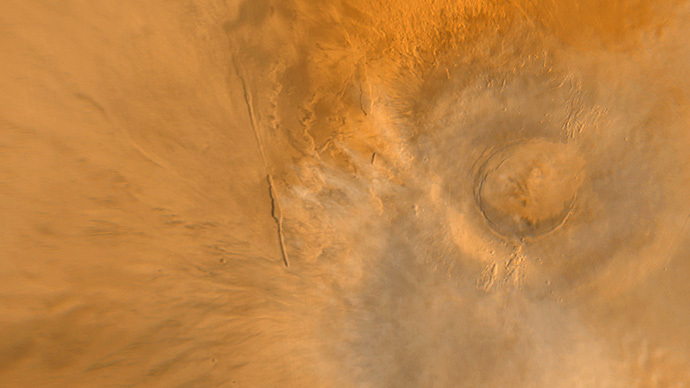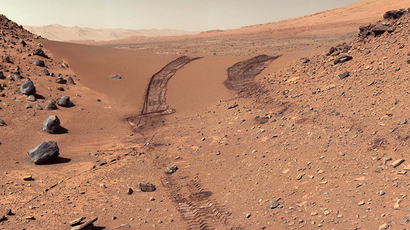Habitable Mars: Scientists find volcano that may have hosted life on Red Planet

Eruptions of a giant Martian volcano, once encased in glacial ice, could have created large lakes of liquid water on the Red Planet in the relatively recent past, scientists say. The presence of water would have meant the area could have been habitable.
One of the largest mountains in the solar system, Arsia Mons, is almost twice as tall as Mount Everest and is the third tallest volcano on Mars.
Geologists from Brown University in the US state of Rhode Island analyzed the landforms surrounding the immense volcano and discovered that eruptions along its northwest flank occurred at the same time that a glacier covered the region around 210 million years ago – which is pretty recently on a geological scale.
During the eruptions, the heat would have melted large amounts of ice, which would then have turned into englacial lakes – bodies of water that form within glaciers like liquid bubbles in a half-frozen ice cube.
“This is interesting because it’s a way to get a lot of liquid water very recently on Mars,” Kat Scanlon of Brown University, who led the work, said.
While Arsia Mons is about 210 million years old, it is much younger than the other habitable environments spotted by Curiosity and other Mars rovers; those sites are more than 2.5 billion years old.
“If signs of past life are ever found at those older sites, then Arsia Mons would be the next place I would want to go,” Scanlon said.

Scanlon, working with Brown geologist Jim Head and Boston University’s David Marchant, examined data from NASA’s Mars Reconnaissance Orbiter and discovered pillow lava formations similar to those that form on Earth when lava erupts on an ocean bed. Additionally, the found ridges and mounds are the kind that form on our planet when a lava flow is constrained by glacial ice.
“The pressure of the ice sheet constrains the lava flow, and glacial meltwater chills the erupting lava into fragments of volcanic glass, forming mounds and ridges with steep sides and flat tops. The analysis also turned up evidence of a river formed in a jökulhlaup, a massive flood that occurs when water trapped in a glacier breaks free,” Brown University stated.
In a paper published in the journal Icarus, researchers analyzed the size of the formations and came up with a conclusion that lava could have produced lakes containing hundreds of cubic kilometers of water.
Despite the Red Planet’s frigid conditions, that water could have remained liquid for hundreds or even a few thousand years, according to Scanlon’s calculations. That may have been long enough for the lakes to be colonized by microbial life forms, if in fact such creatures ever inhabited Mars.
Meanwhile, Head suggested that some of the glacial ice may still be in place on Mars.
“Remnant craters and ridges strongly suggest that some of the glacial ice remains buried below rock and soil debris,” he said. “That’s interesting from a scientific point of view because it likely preserves in tiny bubbles a record of the atmosphere of Mars hundreds of millions of years ago. But an existing ice deposit might also be an exploitable water source for future human exploration.”














